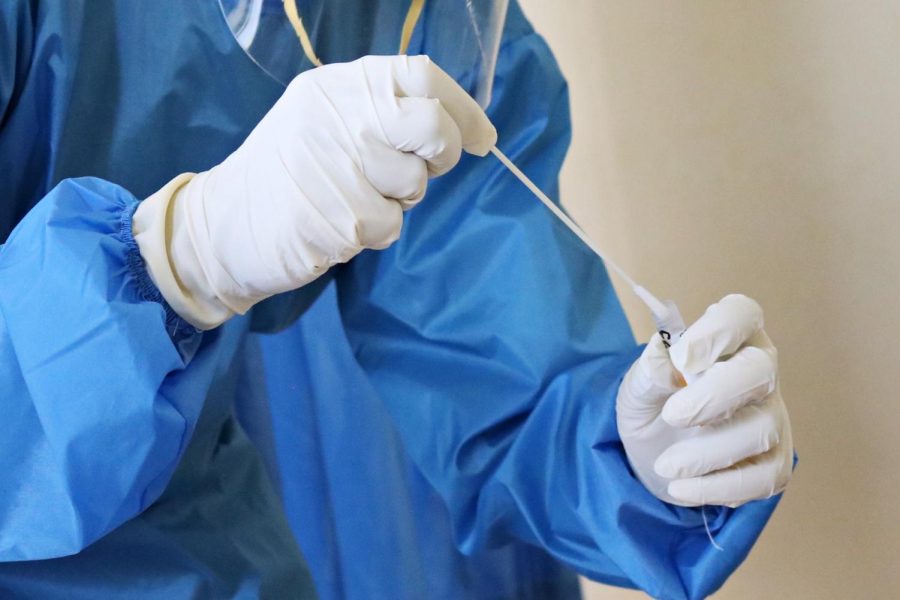Omicron variant spikes COVID-19 cases in public schools
Major universities and secondary schools shut down due to COVID-19 concerns
Pfizer-BioNTech COVID-19 booster shots are available for everyone 12 years and older. Moderna booster shots are available for everyone 18 years and older.
January 11, 2022
The new variant of the coronavirus disease, Omicron, is spreading rapidly throughout the United States. USA Today reports the nation’s daily average of new cases as 550,000. Because this new variant is easily transmitted, Smithson Valley has seen a spike in COVID cases among students and teachers over the past few weeks, with 25 new cases reported on Jan. 10.
Freshman Allison Bailey contracted the Omicron variant from her brother over Christmas break.
“I had a back ache, a headache and nausea,” Bailey said. “Nothing too bad though.”
Bailey, a diligent mask wearer, has been fully vaccinated with Pfizer for 6 months but has not received her booster shot.
“Vaccinations will help slow the transmission and decrease overall mortality,” Regional Critical Care Educator for Baptist Health System Stacey Agleton said. “But I do hear differing stories about vaccinations and the Omicrom variant. Some say vaccines are ineffective, but the booster is helping to lessen transmission.”
The spike in cases around the world is due to the contagiousness of the Omicron Variant.
“This variant is much milder,” Agleton said. “The first variant had many people on ventilators with severe respiratory distress and failure such as pneumonia and kidney failure. People now are experiencing more cold and allergy like symptoms. Headaches, backaches and gastrointestinal symptoms such as nausea and vomiting are signs of Omicron.”
Burbio, an organization that tracks individual school and district websites, reports that 3,798 schools across the United States are not offering in-person instruction as of Jan. 7. Harvard, Stanford and Georgetown University began the new semester with only remote learning.
“I’m not sure how effective this will be in slowing the spread,” Agleton said. “There is already a new variant discovered in south France. Encouraging good hand hygiene and social distancing are the most effective in the prevention of transmission.”
A Chicago teacher union voted on Jan. 4 to not report to school because of COVID concerns. Chicago Chalkbeat reports 73% of voting rank-and-file members opted to pause in-person learning and teach remotely until Jan. 18 or until COVID rates declined. Chicago public schools closed their doors last Wednesday.
“As a district, we continue to leave masking and vaccination a choice left to parents and students,” school nurse Natalie Kuhn said. “I feel students need to be educated about proper precautions to prevent infection and serious illness versus becoming alarmed by the variant.”
As the virus continues to mutate, the end of the pandemic seems to be growing farther away for people like Bailey.
“I’ve taken every measure to stay safe, and I still got COVID,” Bailey said. “It’s frustrating to not see others do the same. I’m so tired of this.”
The lasting effects of COVID are most apparent in hospitals and their staff.
“It has been a very long journey for many of our staff at the hospitals,” Agleton said. “They are overworked, overwhelmed and understaffed. In the beginning of the pandemic, there was much sympathy for the patients contracting COVID, but as time wore on and measures were implemented to help prevent the spread of the virus, some people did not practice the safe measures, and staff became less sympathetic to the ones who were admitted. There were even patients admitted who thought they were being lied to. They did not believe in COVID or the pandemic. Some died because they refused treatment.”
The constant mutation of the coronavirus has blurred the future of the pandemic. Almost 60 million U.S. citizens have contracted the virus.
“I think someday there will be an end to the pandemic as herd immunity helps control transmission,” Agleton said. “But there may always be endemics of the COVID variant. I think this is still our way of life for a while.”



